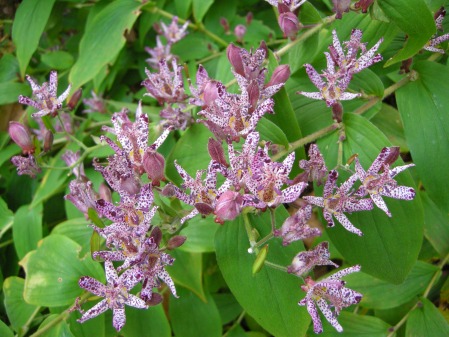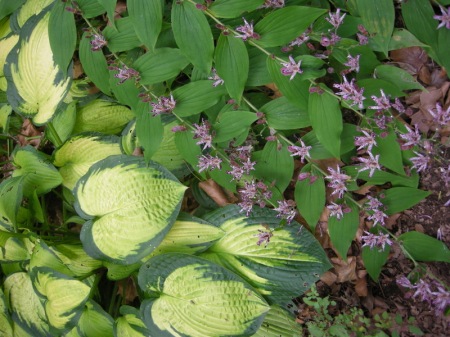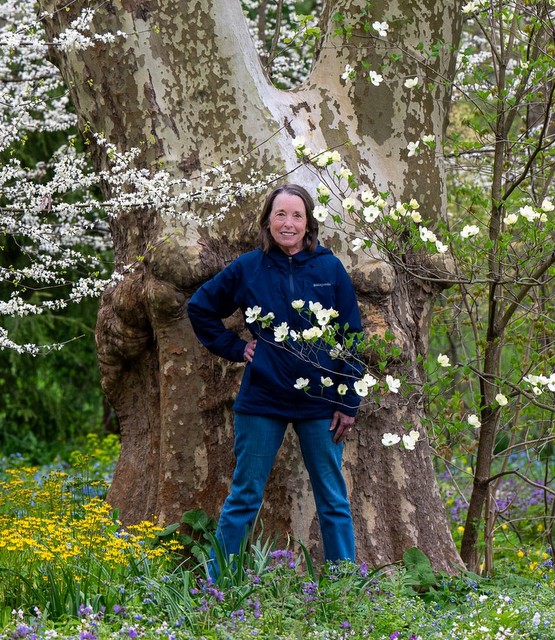Carolyn’s Shade Gardens is a retail nursery located in Bryn Mawr, PA, specializing in showy, colorful, and unusual plants for shade. The only plants that we ship are snowdrops and miniature hostas. For catalogues and announcements of events, please send your full name, location, and phone number (for back up use only) to carolyn@carolynsshadegardens.com. Click here to get to the home page of our website for catalogues and information about our nursery and to subscribe to our blog.
 Bearsfoot hellebore growing in my manure pit wall
Bearsfoot hellebore growing in my manure pit wall
Hybrid hellebores, the variety of hellebore that most gardeners grow with the big, nodding, showy flowers in beautiful colors, are generally not fall-blooming plants. They give depth to the fall garden through their evergreen foliage, but they are not thought of for flowers (except a rogue hybrid bloom now and then). In the mid-Atlantic, they bloom as early as January, but generally start to flower in February. But there are a few species (as opposed to hybrid) hellebores that flower in fall, and my late fall garden has been much enhanced by their addition.
 Winter foliage of bearsfoot hellebore
Winter foliage of bearsfoot hellebore
If I had to choose a favorite hellebore, and I have almost every species and hundreds of hybrids, I would pick the bearsfoot hellebore, Helleborus foetidus. It wouldn’t be for its charming Latin name: foetidus speaks for itself. And not for its alternate common name, stinking hellebore, though it doesn’t deserve that name when you have to mangle the leaves to elicit a smell. Rather I would choose it for its substantial 2′ evergreen presence, like a miniature rhododendron in the garden. And for the interesting spidery texture of its always pristine dark green leaves. But mostly for how its chartreuse bell-like buds and flowers perch atop its beautiful foliage from November into May.
 Fall buds emerging from bearsfoot hellebore
Fall buds emerging from bearsfoot hellebore
Bearsfoot hellebore grows in part to full shade and is the only hellebore that I am aware of that likes slightly moist soil. That being said, my grove—if they are happy, they spread—received no additional water for the entire summer of 2010 when we had the worst heat and drought I have ever experienced. Bearsfoot and all my other hellebores came through with flying colors. I grow all my hellebores with plenty of compost.
 Fall buds of bearsfoot hellebore
Fall buds of bearsfoot hellebore
 Bearsfoot hellebore in full bloom
Bearsfoot hellebore in full bloom
Two other fall-blooming hellebores are superior selections from the true Christmas rose, the species Helleborus niger. Christmas roses are beautiful plants and well worth growing for their outward-facing, starry, pure white flowers and elegant blue-green leaves. But the straight species is sadly mis-named. In the mid-Atlantic, it blooms in March at the earliest when Christmas has long past. However, the amazing plant breeders at Heuger in Germany who have produced the superior Helleborus Gold Collection have developed two Christmas roses that bloom from November into May.
The first, HGC ‘Jacob’, is a compact and refined plant 6 to 8″ tall with graceful, smooth dark green leaves. It starts blooming in mid-November (it was a little late this year) with copious 2 to 3″ white flowers maturing to rose, and continues to produce buds into May. The second is HGC ‘Josef Lemper’, a 10″ plant with 3 to 3 1/2″ flowers and larger, lighter green leaves. It comes into bloom about two weeks later than ‘Jacob’ and also continues to May.
 Christmas rose ‘Jacob’ coming into bloom in November
Christmas rose ‘Jacob’ coming into bloom in November
 Emerging buds of Christmas rose ‘Josef Lemper’
Emerging buds of Christmas rose ‘Josef Lemper’
Christmas roses are a little more finicky than hybrids. Like most hellebores, they prefer well-drained sites with plenty of organic matter. But they have a definite preference for the edges of beds in part shade as opposed to sunnier or shadier spots. My best stand is in an open area shaded by 100′ trees on a steep slope. I have never found that they needed supplemental lime as the books suggest.
I am throwing in the final fall-blooming hellebore more for curiosity sake than for its ornamental value. Over the years, I have collected most of the hellebore species. I have tried to get them from more than one source so I could compare them. The variation is amazing, but no more than hellebore aficionados like Graham Rice will tell you to expect. One plant I have collected is H. dumetorum—it’s so obscure it doesn’t have a common name. Its small green flowers and ordinary leaves do not endear it to gardeners. However, I am including a photograph of one of my plants here because every year it blooms in late October and continues to spring.
For more information on hellebores, I highly recommend noted hellebore expert Graham Rice’s website. The book The Gardener’s Guide to Growing Hellebores by Graham Rice and Elizabeth Strangman is excellent. It includes amazing pictures showing the variation within the different species. I will add both sources permanently to my sidebar so you can always find them. If you really want all the details about hellebores, try Hellebores by Brian Mathew (Alpine Garden Society). It is out-of-print but available at horticultural libraries, including the Pennsylvania Horticultural Society.
Carolyn
This is part one in a series of articles on hellebores, one of the specialties of my nursery. Here are links to all six articles:
Part One Hellebores for Fall
Part Two An Ode to Seed Strain Hellebores
Part Three Christmas Rose: The Perfect Hellebore
Part Four Dividing Hybrid Hellebores
Part Five The Sex Lives of Hellebores
Part Six Double Hellebores
Part Seven Cutting Back Hellebores
Note: Every word that appears in orange on my blog is a link that you can click for more information.









